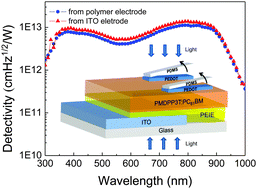Double-side responsive polymer near-infrared photodetectors with transfer-printed electrode†
Abstract
Low dark current is critical to realize high-performance near-infrared organic photodetectors (NIR-OPDs). In general, organic photodetectors (OPDs) are with vacuum-deposited metals as the top electrode. The deposition of such metal would inevitably form doping to the organic active layer and thus yield high dark current. Herein, we employ transfer-printed conducting polymer (tp-CP) as the top electrode instead of the vacuum-deposited metal electrode. The photodetector with tp-CP electrode exhibits over two orders of magnitude lower dark current density than the device with the vacuum-deposited metal electrode. The photodetector with tp-CP electrode displays a responsivity of 0.37 A W−1 at 850 nm and a low dark current density of 3.0 nA cm−2 at −0.2 V based on a near-infrared (NIR) active layer of PMDPP3T:PC61BM that absorbs photons up to 1000 nm. The detectivity of the NIR photodetector reaches as high as over 1013 Jones. Furthermore, the NIR photodetector is double-side responsive to incident light, either from the bottom or the top electrode, because the top tp-CP electrode shows similar transparency as the bottom indium-tin oxide electrode.


 Please wait while we load your content...
Please wait while we load your content...